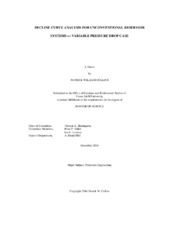| dc.contributor.advisor | Blasingame, Thomas A | |
| dc.creator | Collins, Patrick William | |
| dc.date.accessioned | 2017-03-02T16:51:49Z | |
| dc.date.available | 2017-03-02T16:51:49Z | |
| dc.date.created | 2016-12 | |
| dc.date.issued | 2016-12-09 | |
| dc.date.submitted | December 2016 | |
| dc.identifier.uri | https://hdl.handle.net/1969.1/159107 | |
| dc.description.abstract | The premise of this work is the development, validation, and application of a methodology to forecast production data in unconventional reservoirs where variable rate and pressure drop producing conditions are typically observed. In unconventional reservoirs, it is not common practice to maintain or even arrive quickly upon a constant flowing bottomhole pressure which is the primary assumption for the application of traditional time-rate decline curve analysis. As a result, the application of traditional time-rate relations to these cases yields misleading results at best.
The methodology presented herein involves the application of the rigorous convolution/superposition theory traditionally relied upon for pressure transient or production analysis. Empirical pressure drop normalized rate decline relations are utilized as a proxy for analytical models in the convolution integral and superposed with either measured or calculated flowing bottomhole pressure drop data for the well(s) in question. The ability to incorporate non-linearities such as compressible gas flow and pressure dependent permeability is investigated using pseudopressure transformations and the limitations are outlined clearly.
A three step workflow consisting of diagnostics, model calibration, and production forecasting is first developed before ultimately being validated and applied for a number of simulation and field data cases. The diagnostic stage of the workflow provides the foundation for the proceeding analysis by providing insight into prevailing performance signatures for the well in question. The primary tool for achieving this is the so called “qDb” plot, which is referenced throughout the work. Incorporation of diagnostics minimizes non-uniqueness and guides model parameter selection for the second stage of the workflow. Ultimately, production is forecast into the future according to any number of defined pressure drawdown schedules.
The validation examples in this work successfully demonstrate the workflow for a range of oil and gas cases with and without pressure dependent permeability introduced into the system. In each of the cases, the data was synthetic and was generated by a commercial simulator using unstructured Voronoi gridding. Validation was achieved using a total of five decline models that are relied upon throughout the work and detailed in dedicated Appendices.
Application examples were chosen to reflect representative field cases where the author has found the methodology to be useful from a practical standpoint. Each example aims to emphasize a different problem and outline the strength and limitations of the methodology applied to each. It is here noted that the primary weakness of the methodology is its ability to handle cases with high degrees of non-linearity. This is evident when forecasting a high-pressure/high-temperature shale gas well where drawdowns are very high.
The work is rounded out with the conclusion that the approach introduced herein provides a useful tool for quickly forecasting production under variable pressure drop conditions for both producing and undeveloped wells. The methodology is particularly useful for scenarios where more detailed analytical and numerical modeling techniques may not be feasible analysis options due to data or time limitations. | en |
| dc.format.mimetype | application/pdf | |
| dc.language.iso | en | |
| dc.subject | Decline Curve Analysis | en |
| dc.subject | Reserves | en |
| dc.subject | Unconventional Reservoirs | en |
| dc.subject | Variable Pressure Decline Curve Analysis | en |
| dc.subject | Choke Management | en |
| dc.title | Decline Curve Analysis for Unconventional Reservoir Systems - Variable Pressure Drop Case | en |
| dc.type | Thesis | en |
| thesis.degree.department | Petroleum Engineering | en |
| thesis.degree.discipline | Petroleum Engineering | en |
| thesis.degree.grantor | Texas A & M University | en |
| thesis.degree.name | Master of Science | en |
| thesis.degree.level | Masters | en |
| dc.contributor.committeeMember | Valko, Peter P | |
| dc.contributor.committeeMember | Lowery, Lee L | |
| dc.type.material | text | en |
| dc.date.updated | 2017-03-02T16:51:49Z | |
| local.etdauthor.orcid | 0000-0001-6697-7234 | |


